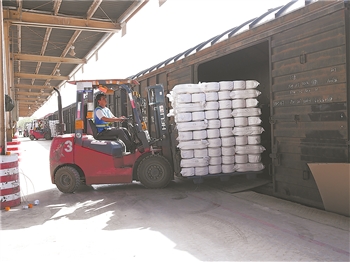
On August 5, at the freight yard platform of Aksu Railway Station on the Southern Xinjiang Railway, a freight train loaded with 2,500 tons of cotton cloth and yarn in 50 boxcars stood ready for departure. These rural revitalization trains are bringing new vitality and opportunities to the vast rural areas of Xinjiang.
According to the head of the freight department at CR-Urumqi, “Railway transport offers large capacity, low cost, high safety and strong timeliness. Launching rural revitalization trains aims to make full use of these advantages to help Xinjiang’s quality products reach wider markets, injecting strong momentum into rural economic development.”
Running rural revitalization trains is also a necessary measure to promote coordinated regional development. Located in China’s northwest border region, Xinjiang is a key hub in the Belt and Road Initiative. By operating high-quality trains, Xinjiang achieves economic synergy and complementary advantages with the inland China, Central Asia and Europe, securing a more important position in the new dual-circulation development pattern of domestic and international markets.
In terms of route planning, CR-Urumqi has conducted in-depth market research, aligning train routes with Xinjiang’s industrial layout and cargo distribution. In transport organization, the “four priorities” have been fully implemented: order placement, wagon allocation, loading, and dispatch. In service quality, the freight department of CR-Urumqi strengthens cooperation with local governments, cotton textile distributors and manufacturers to tailor optimal transport routes and personalized, diversified transport solutions.
The regular operation of rural revitalization trains reduces logistics costs and improves transport efficiency, attracting more enterprises to invest and set up factories in Xinjiang, thereby driving the clustering of Xinjiang’s specialized industries. The trains also bring numerous job opportunities, contributing to social stability and prosperity in rural areas.
 附件:
附件: